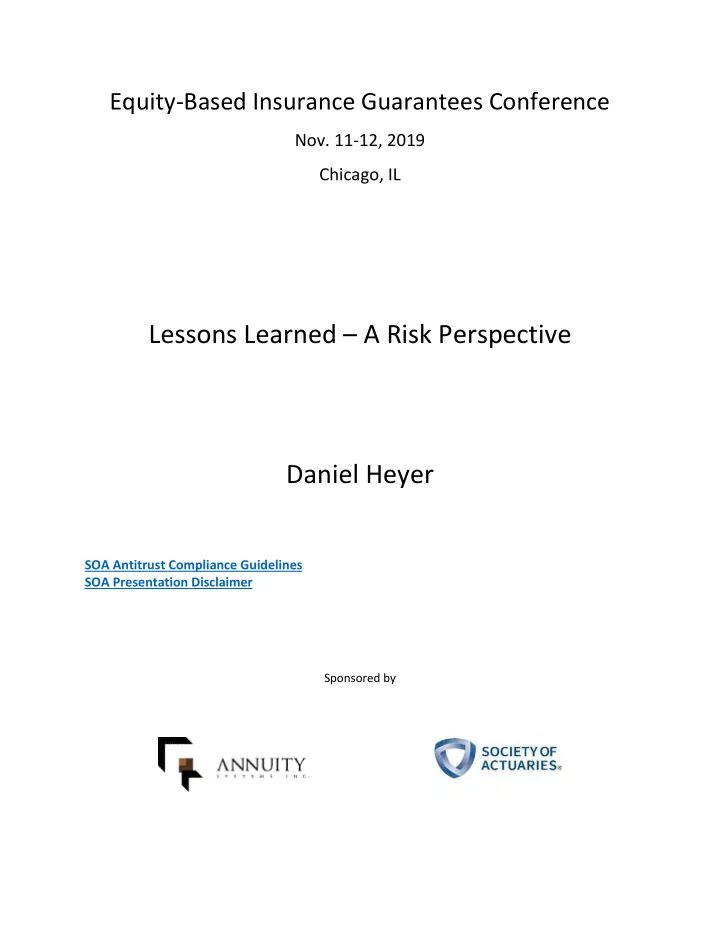

Equity-Based Insurance Guarantees Conference Nov. 11-12, 2019 Chicago, IL Lessons Learned – A Risk Perspective Daniel Heyer SOA Antitrust Compliance Guidelines SOA Presentation Disclaimer Sponsored by
Equity-Based Insurance Guarantees Conference November 12, 2019 (1430-1530 hours) Lessons Learned – A Risk Perspective Daniel Heyer FCAS, CQF Vice President, Model Risk Management Nationwide Insurance
Market Risk is Systematic • GMDBs were the first widespread annuity guarantee, beginning in the 1990s. – Performance guarantee in down markets. – Dual trigger – Policyholder lapsation, withdrawal, and allocation choices • Early feeling was that dual trigger provides strong diversification, and limits opportunity to “optimize” benefit. • Learned otherwise… – In a protracted down-market, your trigger diversification disappears while mortality marches on with certainty. – In a protracted down-market, fee income declines while obligations increase. Lesson 1 Know what breaks the deal. What can go wrong and how bad can it get? EBIG 2019 Lessons Learned November 12, 2019
Product Design Matters • Return of Premium GMDB design has several structural weaknesses. – Lapse/repurchase when benefits are out of the money – Elective allocation to high volatility funds – Dollar-for-Dollar withdrawals • Ratchet GMDB escalates all of these weaknesses. – Certain escalation – Risk escalation • Ratchet GMDB up-market risk exposure came as a surprise to some. Lesson 2 Fully understand what bets you are making. Fully understand the consequences of those bets. EBIG 2019 Lessons Learned November 12, 2019
Dizzying Bet Sophistication GMAB GLWB • Certain payout timing. • Equity-contingent payout timing. • Certain benefit level. • Equity-contingent benefit level. • Equity contingent payout. • Rate contingent payout. • Single payout. • Indeterminant, multi-period payout. • Intelligent elective behavior typically • Intelligent elective behavior increases erodes benefit value. benefit value. • Natural hedge instruments. • No natural hedge instruments. • Dynamic hedging is highly effective. • Convexity and cross limit dynamic hedge effectiveness. Lesson 3 Complex products lead to complex behaviors – and limited choices. EBIG 2019 Lessons Learned November 12, 2019
Seek Simple Hedges that Fail Simply • If you purchase static hedges, you pay the premium and outsource risk management. • If you dynamically hedge, you assume material risk in exchange for lower cost. • Understanding the risk of dynamic hedging is difficult when managing complex risks. Swap Futures Cross Equity Rate Vol Valuation Valuation Vol Vol • Subtle market behaviors can make complex dynamic hedges fail in leveraged ways. Lesson 4 Risk exchange is not the same as risk transfer. EBIG 2019 Lessons Learned November 12, 2019
Building Institutional Understanding of Hedging • A lot of intuition that works well for retained financial risk (actuarial pricing) doesn’t necessarily translate well to financial risk transfer (hedging, market valuation) • Some important examples of misunderstanding… – Schroedinger’s Cat Hedges ( simultaneously dynamic and static ) – Big Foot Hedges ( everyone has seen Big Foot on YouTube… ) – Potemkin Hedges ( they seem like the real deal… ) – Feyman-Kac Theorem ( a.k.a. Risk-Neutral Scenarios ) – The Amicable ESG Conundrum ( why we all need a few good enemies ) Lesson 5 Deep understanding of the math is essential (but not sufficient). EBIG 2019 Lessons Learned November 12, 2019
Make Sure Your ESG Reflects Your Opinions • Risk-Neutral ESGs are mechanical extensions of your valuation model. • Real-World ESGs are judgmental assessments of Risk and Reward. • Need to make sure we reflect things we really believe. – Forecastable rates and volatility – Volatility/Return causation – No-Arbitrage Conundrum – Free Money Machines – Eye-o-Meter evaluations • Understanding what you care about is hard. Developing and managing models that addresses those cares is even harder. Lesson 6 Don’t be surprised when your decisions are 100% consistent with your opinions. EBIG 2019 Lessons Learned November 12, 2019
Managed Funds and Indices • Managing the underlying fund performance to simultaneously provide a sound customer value proposition and to manage insurance company capital volatility – pure genius! • Performance story for early funds was sometimes disappointing. – Insurance isn’t an alpha-generator – Weak designs bet on forecastable volatility and returns – Undiversified high-volume always gets picked-off. • Effort has moved to Proprietary Crediting Indices – Sound diversification – High complexity leads to significant over-optimization potential. – High cost + difficult value assessment Lesson 7 Clearly-differentiated, low-complexity products lead to the best outcomes for everyone. EBIG 2019 Lessons Learned November 12, 2019
Statutory Accounting Hedges • When you are hedging a GAAP Fair-Value Liability there is natural income alignment with hedge assets. • Overall impact of Fair-Value hedging is to react early, and settle down after claim is relatively certain. • When you are hedging a STAT Reserve or Capital several potential mismatches arise. – Use of real-world scenarios for valuation – Use of portfolio rates for discounting – Use of catch-up mechanisms (e.g. SOP 03-1 benefit ratio) – Overall impact is to smooth valuations, and only react when claim is relatively certain. • Statutory Greek-matching leads to increasing protection after stress market events. Lesson 8 Buying insurance after the house has caught fire is expensive and does little to transfer risk. EBIG 2019 Lessons Learned November 12, 2019
Other Thoughts for Discussion • Policyholder Behavior – Expected vs Deterministic vs Stochastic models of behavior – Is complexity really your friend? • Framework controls for pricing, hedging, and valuation – Controls ensuring safe operation – Controls warning of potential failure – Importance of active oversight • Integrated systems for pricing, hedging, and valuation – Ensuring consistency – Avoiding false consistency – Building for speed and efficiency EBIG 2019 Lessons Learned November 12, 2019
Discussion If only I had known… EBIG 2019 Lessons Learned November 12, 2019
Recommend
More recommend